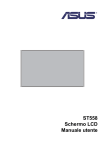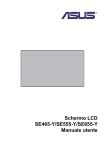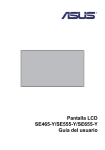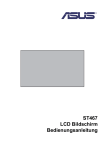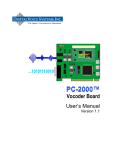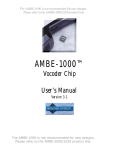Download ASUS ST558
Transcript
ST558 LCD Display User Guide The information contained in this document is subject to change without notice. This document contains proprietary information that is protected by copyright. All rights are reserved. No part of this document may be reproduced, translated to another language or stored in a retrieval system, or transmitted by any means, electronic, mechanical, photocopying, recording, or otherwise, without prior written permission. Windows is a registered trademark of Microsoft, Inc. Other brands or product names are trademarks of their respective holders. Important Recycle Instruction: This product may contain electronic waste that can be hazardous if not disposed of properly. Recycle or dispose in accordance with local, state, or federal Laws. For more information, contact the Electronic Industries Alliance at WWW.EIAE.ORG. Table of Contents Table of Contents Safety warnings and precautions.................................................. 3 Important safety instructions ........................................................ 4 Notes on the LCD panel of this display ................................................... 5 Safety notice for remote control............................................................... 5 Battery safety notice ................................................................................ 5 Notes on moving the display ................................................................... 6 Package contents ........................................................................... 7 Setting up the display..................................................................... 8 Mounting the display................................................................................ 8 Installing the display on a wall ........................................................... 8 Parts of the display and their functions ....................................... 9 Rear panel .............................................................................................. 9 Input/output terminals .............................................................................. 10 Remote control ........................................................................................ 12 Using the remote control ......................................................................... 13 Installing remote control batteries ...................................................... 13 Remote control usage tips ................................................................. 13 Connection ...................................................................................... 14 Connecting audio/video signals............................................................... 14 Connecting the VGA input ................................................................. 14 Connecting the YPbPr component video input .................................. 15 Connecting the S-Video input ............................................................ 16 Connecting the composite video (AV) input....................................... 17 Connecting the DVI-D digital input..................................................... 18 Connecting the HDMI digital input ..................................................... 19 Connecting the DisplayPort (DP) digital input.................................... 20 Connecting external speakers ........................................................... 21 Connecting multiple displays ............................................................. 22 Connecting power.................................................................................... 23 Basic operations ............................................................................. 24 Turning the display on or off .................................................................... 24 Locking/unlocking the controls ................................................................ 24 Switching input signals ............................................................................ 24 Adjusting audio volume level ................................................................... 24 Network connection........................................................................ 25 Connecting the display to a local area network ....................................... 25 Remote network control........................................................................... 26 Information ......................................................................................... 26 Picture & Sound ................................................................................. 27 Screen................................................................................................ 27 Setting................................................................................................ 28 Schedule ............................................................................................28 1 2 Table of Contents Mail Report ........................................................................................ 29 Network ............................................................................................. 33 RS232 commands over the network ....................................................... 34 The OSD (On-Screen Display) menu ............................................. 35 OSD menu overview ............................................................................... 35 Operations in the OSD menu .................................................................. 37 Picture menu .......................................................................................... 38 Sound menu............................................................................................ 39 Screen menu........................................................................................... 40 Setting menu ........................................................................................... 42 Product information........................................................................ 44 Specifications .......................................................................................... 44 Dimensions ............................................................................................. 46 Remote control codes ............................................................................. 47 Supported input signal resolution............................................................ 48 Supported PAP input signal combination................................................ 50 Troubleshooting.............................................................................. 51 Safety warnings and precautions 3 Safety warnings and precautions The lightning flash with arrowhead symbol, within an equilateral triangle, is intended to alert the user to the presence of uninsulated "dangerous voltage" within the product's enclosure that may be of sufficient magnitude to constitute a risk of electric shock to persons. The exclamation point within an equilateral triangle is intended to alert the user to the presence of important operating and maintenance (servicing) instructions in the literature accompanying the appliance. THIS EQUIPMENT MUST BE GROUNDED To ensure safe operation, the three-pin plug must be inserted only into a standard three-pin power outlet which is effectively grounded through normal household wiring. Extension cords used with the equipment must have three cores and be correctly wired to provide connection to the ground. Wrongly wired extension cords are a major cause of fatalities. The fact that the equipment operates satisfactorily does not imply that the power outlet is grounded or that the installation is completely safe. For your safety, if you are in any doubt about the effective grounding of the power outlet, please consult a qualified electrician. • The mains plug of the power supply cord shall remain readily operable. The AC receptacle (mains socket outlet) shall be installed near the equipment and shall be easily accessible. To completely disconnect this equipment from the AC mains, disconnect the power cord plug from the AC receptacle. • Do not place this display on an uneven, sloping or unstable surface (such as a trolley) where it may fall and cause damage to itself or others. • Do not place this display near water, like a spa or pool, or in a position which will allow the splashing or spraying of water onto the display, like in front of an open window where rain water may enter. • Do not install this display in a confined space without proper ventilation and air circulation, such as in a closed cabinet. Allow proper space around the display for dissipating heat inside. Do not block any openings and vents on the display. Overheating may result in hazards and electric shock. • Installation of this display should only be performed by a qualified technician. Failure to install this display properly may cause injuries and damages to the personnels and the display itself. Check the installation regularly and maintain the display periodically to ensure the best working condition. • Use only the accessories approved or recommended by the manufacturer to mount this display. Using wrong or unsuitable accessories may cause the display to fall and result in serious personal injuries. Make sure that the surface and fixing points are strong enough to sustain the weight of the display. • To reduce the risk of electric shock, do not remove covers. No user serviceable parts inside. Refer servicing to qualified service personnel. • To prevent personal injuries, mounting the display or installing desktop stands is required before use. 4 Important safety instructions Important safety instructions 1. 2. 3. 4. 5. 6. 7. 8. 9. 10. 11. 12. 13. 14. Read these instructions. Keep these instructions. Heed all warnings. Follow all instructions. Do not use this apparatus near water. Clean only with dry cloth. Do not block any ventilation openings. Install in accordance with the manufacturer's instructions. Do not install near any heat sources such as radiators, heat registers, stoves, or other apparatus (including amplifiers) that produce heat. Do not defeat the safety purpose of the polarized or grounding-type plug. A polarized plug has two blades with one wider than the other. A grounding-type plug has two blades and a third grounding prong. The wide blade or the third prong are provided for your safety. If the provided plug does not fit into your outlet, consult an electrician for replacement of the obsolete outlet. Protect the power cord from being walked on or pinched particularly at plugs, convenience receptacles, and the point where they exit from the apparatus. Only use attachments/accessories specified by the manufacturer. Use only with the cart, stand, tripod, bracket, or table specified by the manufacturer, or sold with the apparatus. When a cart is used, use caution when moving the cart/apparatus combination to avoid injury from tip-over. Unplug this apparatus during lightning storms or when unused for long periods of time. Refer all servicing to qualified service personnel. Servicing is required when the apparatus has been damaged in any way, such as power-supply cord or plug is damaged, liquid has been spilled or objects have fallen into the apparatus, the apparatus has been exposed to rain or moisture, does not operate normally, or has been dropped. Important safety instructions 5 Notes on the LCD panel of this display • The Liquid Crystal Display (LCD) panel of this display has a very thin protective layer of glass which is liable to marking or scratching, and cracking if struck or pressured. The liquid crystal substrate is also liable to damage under excessive force or extreme temperatures. Please handle with care. • The response time and brightness of the LCD panel may vary with the ambient temperature. • Avoid placing the display in direct sun or where direct sun or spot lighting will shine onto the LCD panel, as the heat may damage the panel and the external casing of the display, and the bright light will make viewing the display more difficult than necessary. • The LCD panel consists of individual pixels to display images and is manufactured according to the design specifications. While 99.9% of these pixels work normally, 0.01% of the pixels may remain constantly lit (in red, blue or green) or unlit. This is a technical limitation of the LCD technology and is not a defect. • LCD screens, like plasma (PDP) and conventional CRT (Cathode Ray Tube) screens, are also susceptible to 'screen burn-in' or 'image retention' which can be found on the screen as visible fixed lines and shades. To avoid such damage to the screen, avoid displaying still images (like On-Screen Display menus, TV station logos, fixed/inactive text or icons) for more than two hours. Change the aspect ratio from time to time. Fill the entire screen with the image and eliminate the black bars whenever possible. Avoid displaying images in 4:3 aspect ratio over a long period of time, otherwise there may be visible burn marks on the screen as two vertical lines. If display of a still image is required, it is recommended to enable Image Retention under the Setting > Advanced menu. Note: • Under certain circumstances, condensation may occur on the inner side of the cover glass, it's a natural phenomenon and will not affect the operation of the display. This condensation will usually disappear after around 2 hours of normal operation. Safety notice for remote control • Do not put the remote control in the direct heat, humidity, and avoid fire. • Do not drop the remote control. • Do not expose the remote control to water or moisture. Failure to do so could result in malfunction. • Confirm there is no object between the remote control and the remote sensor of the product. • When the remote control will not be used for an extended period, remove the batteries. Battery safety notice The use of the wrong type of batteries may cause chemical leaks or explosion. Please note the following: • Always ensure that the batteries are inserted with the positive and negative terminals in the correct direction as shown in the battery compartment. • Different types of batteries have different characteristics. Do not mix different types. • Do not mix old and new batteries. Mixing old and new batteries will shorten battery life or cause chemical leaks from the old batteries. • When batteries fail to function, replace them immediately. • Chemicals which leak from batteries may cause skin irritation. If any chemical matter seeps out of the batteries, wipe it up immediately using a dry cloth, and replace the batteries as soon as possible. • Due to varying storage conditions, the battery life for the batteries included with your product may be shortened. Replace them within 3 months or as soon as you can after initial use. • There may be local restrictions on the disposal or recycling of batteries. Consult your local regulations or waste disposal provider. 6 Important safety instructions Notes on moving the display The display has limited mechanical strength. To prevent the display from performance failure caused by line defects, front bezel bending, glass scratch/broken, light leakage, etc, it must be handled with care. • Always move the display by at least two (2) adults. • When you want to move the display, make sure the four (4) handles are held. • When you want to place the display face down: - Prepare a flat and horizontal surface that is larger than the display and spread a thick protective sheet on it. Support surface - Lay down the display gently and horizontally. • When you want to upturn the display: - Lift the display up horizontally by holding the four (4) handles. Do not lift the display against its corner. - Be careful not to scratch any parts of the display when upturning the display. - Stand the display vertically to make sure the its weight spread evenly on the surface. - Check the shock label on the outside of the product carton. The shock indicator on the label will turn red if the display/package is improperly handled. Package contents 7 Package contents Open the sales package and check the contents. If any item is missing or damaged, please contact your dealer immediately. LCD display Power cord D-Sub (15-pin) cable IR extender cable Remote control AAA batteries Quick start guide Audio cable Gap inspection pads Notes: • The type of power cord supplied may differ from that illustrated depending on your region of purchase. • Before discarding the package, check that you haven't left any accessories inside the box. • Dispose of packaging materials wisely. You can recycle the cardboard carton. Consider storing the package (if possible) for future transport of the display. • Do not leave plastic bags within reach of young children or babies. 8 Setting up the display Setting up the display Mounting the display You can install the display on a vertical surface with a suitable wall mounting bracket or on a horizontal surface with a table stand. Please pay attention to the following notes during installation: • This display should be installed by at least two adult persons. Attempting to install this display by only one person may result in danger and injuries. • Refer the installation to qualified technicians. Improper installation may cause the display to fall or malfunction. Installing the display on a wall 1. Place a clean, dry and lint-free cloth on a flat, horizontal and object-free surface. Make sure that the size of the cloth is larger than the display. 2. Gently lay the display on the cloth with the LCD screen facing down. 3. Identify the wall mounting screw holes on the back of the display as shown in the illustration. 400mm (15.75”) Note: • Screw type: M6 x 20 mm 400mm (15.75”) 4. Install the wall mounting bracket on the display and attach the display to the wall according to the mounting bracket’s instructions. The length of the screw should exceed the thickness of the wall mounting bracket by at least 10 mm. Make sure that all screws are tightened and secured properly. (Recommended torque: 470 - 635N•cm). The mounting means should be strong enough to bear the weight of the display. Thickness of the wall mounting bracket Display 10 mm (0.39") Notes: • To maintain proper ventilation, keep at least 10 mm of clear space from the back cover of the display to the wall. • Please consult a professional technician for wall mount installations. The manufacturer accepts no liability for installations not performed by a professional technician. • The AC power input socket should be on top of connectors when rotating your display. 10mm (0.39") Parts of the display and their functions 9 Parts of the display and their functions Rear panel 1 2 No. 1 2 Name 3 4 4 5 6 Description • Receives command signals from the remote control. • Detects ambient lighting conditions around the display and adjusts screen brightness automatically when the Ambient Light Sensor function is activated. • Indicates the operating status of the display: Remote control sensor / - Lights up green when searching for inputs. Ambient light sensor / - Lights up red when the display is in Power Save High Power indicator mode. - Flashes red when the display is in Power Save Low mode. - Off when the main power is turned off. • Selects a video source. ENTER/VIDEO SOURCE • Confirms your selection or enters a submenu in the On-Screen Display (OSD) menu. MENU Opens or closes the OSD menu. 4 , , /-,/+ • Scrolls through settings and options in the OSD menu. • /-,/+: Hot keys for audio volume adjustment. 5 Power button Turns the display on or off. Power indicator Indicates the power status of the display: - Lights up green when searching for inputs. - Lights up red when the display is in Power Save High mode. - Flashes red when the display is in Power Save Low mode. - Off when the main power is turned off. 3 6 10 Parts of the display and their functions Input/output terminals 1 2 No. 3 4 5 Name 6 7 8 9 10 11 12 13 14 15 16 17 18 19 20 Description RJ-45 Connects to the RJ-45 port on a computer or Ethernet switch/router. 2 RS-232C IN/OUT For external control and multi-display operation. • RS-232C IN: receives control signals from a computer or another display. • RS-232C OUT: outputs control signals from the RS-232C IN input to another display. 3 DISPLAY PORT Connects to a DisplayPort compatible device. 4 DVI-OUT Outputs DVI signals from the DVI-IN input socket to another display. 5 DVI-IN 1 6 HDMI-1/HDMI-2 7 VIDEO IN (YPbPr) 8 VIDEO IN (S-VIDEO) 9 AV OUT 10 AV IN 11 VGA OUT 12 VGA IN 13 AUDIO IN (AUDIO 1) 14 AUDIO IN (AUDIO 2) 15 AUDIO OUT (L/R) Receives DVI signals from an external device (such as a computer). Receives HDMI signals from an external device (such as a Blu-ray disc player). Receives component video (YPbPr) signals from an external device (such as a DVD player, HDTV device or Laser disc player). Receives S-Video signals from an external device (such as a VCR or DVD player). Outputs composite video signals from the AV IN input socket to another display. Receives composite video signals from an external device (such as a VCR or DVD player). Outputs analog RGB signals from the VGA IN input socket to another display. Receives analog RGB signals from an external device (such as a computer). Receives audio signals from an external device (such as a computer). Receives audio signals from an external device (such as a VCR or DVD player). Outputs audio signals to an external device. Parts of the display and their functions 16 IR-IN/IR-OUT • IR-IN: For use with an IR extender cable - to ensure better signal reception from the remote control. • IR-OUT: Outputs the IR signal from the IR-IN input socket to another display. 17 SPEAKERS (R/L) Outputs audio signals to external speakers. 18 AC SWITCH ON/OFF Turns on or off the main power. 19 AC power input Connects to a power outlet via the supplied power cord. 20 AC power output Relays the AC power from the AC power input socket to another display. 11 12 Parts of the display and their functions Remote control 6 INFO Shows the current input source and resolution. 1 7 Numeric (1-9)/Input source buttons 2 3 6 • Functions as numeric buttons when the OSD menu is on. • Functions as direct input source selection buttons when the OSD menu is off. 7 Note: • The SDI and MULTI-MEDIA functions are not available with this display. 8 9 4 10 5 8 MENU Opens or closes the OSD menu. 9 Numeric button (0)/MUTE • Performs as a numeric button when the OSD menu is on. • Turns on or off the mute function when the OSD menu is off. 10 / Scrolls through settings and options in the OSD menu. 11 1 ON/OFF Turns the display on or off. 2 INPUT Opens the input source list for selecting an input source. 3 EXIT Returns to a previous OSD menu or closes the OSD menu. 4 / VOL- // VOL+ • Scrolls through settings and options in the OSD menu. • Turns down/up the volume. 5 ENTER Confirms your selection or save changes in the OSD menu. 11 MULTI-MEDIA buttons These functions are not available with this display. Parts of the display and their functions 13 Using the remote control Installing remote control batteries 1. Open the remote control battery compartment cover. 2. Insert the supplied batteries ensuring that the positive and negative marked battery terminals match the (+) and (-) marks in the battery compartment. Note: • The supplied batteries are provided for your convenience so that you can operate the display straight away. You should replace them as soon as possible. 3. Refit the battery compartment cover. Remote control usage tips • Point and aim the top front of the remote control directly at the display's remote control sensor window or IR sensor on extender cable when pressing the buttons. • Do not let the remote control become wet or place it in humid environments (like bathrooms). • If the display’s remote control sensor is exposed to direct sunlight or strong light, the remote control may not operate properly. In this situation, change the light source, readjust the angle of the display or operate the remote control from a location closer to display’s remote control sensor. Max. 10 m (32.8 feet) 14 Connection Connection Connecting audio/video signals Pay attention to the following notes when you connect cables: • Please turn off all devices. • Familiarize yourself with the audio/video ports on the display and the devices you want to use. Be aware that incorrect connections may adversely affect picture quality. • Do not remove cables from the ports by pulling the cable itself. Always grasp and pull the connectors at the end of the cable. • Ensure that all cables are fully inserted and firmly seated. Connecting the VGA input 1. Connect the VGA IN jack on the display to the VGA output jack on a computer using the supplied D-Sub (15-pin) cable. 2. Connect the computer’s audio output jack to the AUDIO IN (AUDIO 1) jack on the display using a suitable audio cable. To select an appropriate audio source, see "Audio Source" on page 39 for details. 3. To view images from this input, press the VGA button on the remote control, or select VGA from the source selection bar. D-Sub (15-pin) cable Audio cable Computer Note: • The audio cable is not supplied and should be purchased separately. Connection 15 Connecting the YPbPr component video input 1. Connect the VIDEO IN (YPbPr) jacks on the display to the component output jacks on an A/V device (such as a VCR or DVD player) using a component video cable. 2. Connect the A/V device’s audio output jacks to the AUDIO IN (AUDIO 2) jacks on the display using a suitable audio cable. To select an appropriate audio source, see "Audio Source" on page 39 for details. 3. To view video image from this input, press the YPbPr button on the remote control, or select YPbPr from the source selection bar. Component video cable Audio cable DVD player / VCR Note: • The cables are not supplied and should be purchased separately. 16 Connection Connecting the S-Video input 1. Connect the VIDEO IN (S-VIDEO) jack on the display to the S-Video output jack on an A/V device (such as a VCR or DVD player) using a composite video cable. 2. Connect the A/V device’s audio output jacks to the AUDIO IN (AUDIO 2) jacks on the display using a suitable audio cable. To select an appropriate audio source, see "Audio Source" on page 39 for details. 3. To view images from this input, press the INPUT button on the remote control and select S-Video from the source selection bar. S-Video cable Audio cable DVD player / VCR Note: • The cables are not supplied and should be purchased separately. Connection 17 Connecting the composite video (AV) input 1. Connect the AV IN jack on the display to the composite video (AV) output jack on an A/ V device (such as a VCR or DVD player) using a composite video cable. 2. Connect the A/V device’s audio output jacks to the AUDIO IN (AUDIO 2) jacks on the display using a suitable audio cable. To select an appropriate audio source, see "Audio Source" on page 39 for details. 3. To view video image from this input, press the AV button on the remote control, or select AV from the source selection bar. Composite video cable Audio cable DVD player / VCR Note: • The cables are not supplied and should be purchased separately. 18 Connection Connecting the DVI-D digital input 1. Connect the DVI-IN jack on the display to the DVI-D output jack on a computer using a DVI-D cable. 2. If needed, connect the computer’s audio output jack to the AUDIO IN (AUDIO 1) jack on the display using a suitable audio cable. To select an appropriate audio source, see "Audio Source" on page 39 for details. 3. To view video image from this input, press the DVI button on the remote control, or select DVI from the source selection bar. DVI-D cable Audio cable Computer Note: • The cables are not supplied and should be purchased separately. Connection 19 Connecting the HDMI digital input 1. Connect the HDMI-1 or HDMI-2 jack on the display to the HDMI output jack on a Blu-ray disc player using an HDMI cable. 2. To view video image from this input, press the HDMI-1 or HDMI-2 button on the remote control, or select HDMI1 or HDMI2 from the source selection bar. HDMI cable Blu-ray disc player Note: • The cables are not supplied and should be purchased separately. 20 Connection Connecting the DisplayPort (DP) digital input 1. Connect the DISPLAY PORT jack on the display to the DisplayPort output jack on a computer using a DisplayPort cable. 2. To view video image from this input, press the DP button on the remote control, or select DisplayPort from the source selection bar. DisplayPort cable Computer Note: • The cables are not supplied and should be purchased separately. Connection Connecting external speakers The built-in amplifier on the display allows you to output audio signals through external speakers. Connect external speakers to the SPEAKERS (R/L) jacks on the display. External speakers Note: • You can use the remote control or the control panel on the display to adjust the volume. 21 22 Connection Connecting multiple displays You can connect multiple displays serially (daisy chain connection) to a computer for management. The number of displays you can connect serially depends on the resolution of the input signal you use. Additional display RS-232C cable DVI-D cable AV cable D-Sub (15-pin) cable IR cable The first display Notes: • This RS-232C daisy chain connection requires an RS-232C port equipped computer. • Use RS-232C serial null modem cables for daisy chain connection. • Avoid using HDCP source for daisy chain connection. Connection 23 Connecting power 1. Plug one end of the power cord into the AC power input socket on the display and the other end into an appropriate power outlet (if the outlet is switched, turn on the switch). 2. Flick the AC SWITCH ON/OFF switch to the ON position to turn on the main power. 2 1 Notes: • The supplied power cord is suitable for use with 100-240V AC power only. • The power cord and outlet illustrated may differ from the ones used in your region. • Only use an appropriate power cord for your region. Never use a power cord which appears damaged or frayed, or change the plug type on the power cord. • Be aware of the power loading when you use extension cords or multiple outlet power boards. • There are no user serviceable parts in this display. Never unscrew or remove any covers. There are dangerous voltages inside the display. Turn off the power and unplug the power cord if you intend to move the display. 24 Basic operations Basic operations Turning the display on or off To turn on or off the display, press the Power button on the display’s control panel or the ON and OFF buttons on the remote control. Notes: • The display’s standby mode still consumes power. To completely cut off power supply, set the power switch to the off position or disconnect the power cord from the power outlet. • The display follows the VESA approved DPM Power Management function. The power management function is an energy saving feature that automatically reduces the display’s power consumption when the keyboard or the mouse has not been used for a fixed period. Locking/unlocking the controls You can lock/unlock the control panel to prevent unwanted or accidental operations. Control panel buttons To lock/unlock the control panel buttons, press and hold the /- and /+ buttons on the control panel simultaneously for at least 5 seconds. Once locked, the control panel buttons do not function unless unlocked. Remote control functions To lock/unlock the remote control functions, press and hold the MENU and /- buttons on the control panel for at least 5 seconds. Once locked, the display does not respond to any remote control operations unless unlocked. To lock/unlock both the control panel and remote control buttons, press the button for at least 5 seconds, and then the ENTER button on the remote control. Once locked, the control panel and remote control buttons do not function unless unlocked. Switching input signals Press the INPUT button or the input source buttons on the remote control, or the INPUT button on the control panel to select an input signal. Adjusting audio volume level Press the /- or/+ button on the control panel, or the VOL+ or VOL- button on the remote control to adjust the volume. Network connection 25 Network connection Connecting the display to a local area network To set the display to connect to a local area network (LAN): 1. Connect a RJ45 cable to the corresponding ports on the display and your LAN switch or router. 2. Open the OSD menu. Go to Setting > Control Setting and select LAN. 3. Go to Setting > Network Settings and perform either of the following settings according to your network environment. You may need to contact your network administrator for assistance on these settings. - If you are in a DHCP environment (the IP address of the display will be automatically assigned by a DHCP server), select DHCP > Execute and press the ENTER button on the remote control. Once the display is successfully connected, the IP Address, Subnet Mask, Default Gateway, Primary DNS, and Secondary DNS information will be displayed. - If you are not in a DHCP environment (the IP address of the display has to be configured manually), select Manual > Execute and press the ENTER button on the remote control. Contact your network administrator for information on the IP Address, Subnet Mask, Default Gateway, Primary DNS, and Secondary DNS settings and enter them accordingly using the numeric buttons on the remote control. 4. To save the settings and return to the previous menu, highlight Execute and press the ENTER button on the remote control. 26 Network connection Remote network control Once the display is connected via LAN connection, you can access the display’s built-in remote network control interface using a computer and the display’s IP address. Notes: • The computer and display must have the same Subnet Mask, Default Gateway, Primary DNS and Secondary DNS settings. • You cannot control the display via the RS-232C connection when LAN control is in use. However, you can set the TCP port number of the LAN connection to 4660 if you want to control the display using RS-232 protocol. See "RS232 commands over the network" on page 34. • The recommended Internet browser is Internet Explorer version 7.0 or higher. 1. Enter the IP address of the display (can be found in the Setting > Information OSD menu) in the address bar of the Internet browser and press Enter. 2. The remote network control interface appears. Information The Information page provides general information about the display. Network connection 27 Picture & Sound The Picture & Sound page provides options for picture and sound adjustments. For more information about how to adjust these settings, please refer to "Picture menu" on page 38 and "Sound menu" on page 39. Note: • Make sure the Setting > Control Setting menu is set to LAN, and the Setting > Power Save menu is set to Low or Off if you would like to turn on the display from a web page. If the Setting > Power Save menu is set to High, the Power ON button will be disabled (grayed out). Screen The Screen page provides options related to display adjustments. For more information about how to adjust these settings, please refer to "Screen menu" on page 40. 28 Network connection Setting The Setting page provides options for advanced display adjustments. For more information about how to adjust these settings, please refer to "Setting menu" on page 42. Schedule The Schedule page provides options for configuring current time and date, and up to 7 schedule settings for the display to turn on and off automatically. For more information about how to set up schedules, please refer to "Schedule" on page 42. Network connection 29 Mail Report The Mail Report page provides options for configuring email server settings for sending status or alert reports from the display. Configuring mail server settings The mail server settings must be correctly configured for the display to send email messages. 1. Specify the recipient’s and sender’s email addresses and email subject under Email Setting. 2. Obtain the server address, user name and password information from your email server administrator and enter them in the corresponding fields under SMTP Setting. 3. If you want the display to send a status report periodically, check the Status Report chceckbox and specify the time and day of the week when the report will be sent. 4. Click the Submit button to complete setup. You can also click the E-Mail Test button to set the display to send a test email for verification. 30 Network connection Status report If activated, a status report will be generated and sent periodically according to your settings in the Mail Report page. Below is an example of the format and content of the status report. Status Report [Display] Model Name: (Model name of the display) Serial No.: (Serial number of the display) [STATUS] Power Status: Power On Video Source: HDMI1 PAP Enable: Off [Network] IP Address: xx.xx.xx.xx Subnet Mask: xx.xx.xx.xx Gateway: xx.xx.xx.xx Primary DNS: xx.xx.xx.xx Secondary DNS: xx.xx.xx.xx MAC Address: xx:xx:xx:xx:xx:xx [Other Information] Scaler F/W Version: x.x Lan F/W Version: x.xx Revx Operation: 0000008H Network connection 31 Alert report - thermal error If the display’s ambient temperature exceeds 50oC (122oF) for over 30 seconds, a thermal error alert report will be generated and sent to the specified recipient. Below is an example of the format and content of the report. Thermal Error [Display] Model Name: (Model name of the display) Serial No.: (Serial number of the display) [STATUS] Power Status: Power On Video Source: HDMI1 PAP Enable: Off [Network] IP Address: xx.xx.xx.xx Subnet Mask: xx.xx.xx.xx Gateway: xx.xx.xx.xx Primary DNS: xx.xx.xx.xx Secondary DNS: xx.xx.xx.xx MAC Address: xx:xx:xx:xx:xx:xx [Other Information] Scaler F/W Version: x.x Lan F/W Version: x.xx Revx Operation: 0000008H If a thermal error alert occurs, turn off the display and check if the space or passage around the display for heat dissipation is blocked. Improve ventilation and air circulation around the display if necessary. 32 Network connection Alert report - voltage error If a fluctuation in DC power supply to the display’s internal components (scaler IC and backlight) occurs, a voltage error alert report will be generated and sent to the specified recipient, and the display will turn off automatically. Below is an example of the format and content of the report. Voltage Error [Display] Model Name: (Model name of the display) Serial No.: (Serial number of the display) [STATUS] Power Status: Power On Video Source: HDMI1 PAP Enable: Off [Network] IP Address: xx.xx.xx.xx Subnet Mask: xx.xx.xx.xx Gateway: xx.xx.xx.xx Primary DNS: xx.xx.xx.xx Secondary DNS: xx.xx.xx.xx MAC Address: xx:xx:xx:xx:xx:xx [Other Information] Scaler F/W Version: x.x Lan F/W Version: x.xx Rev x Operation: 0000008H If a voltage error alert occurs, consider the following measures: • Check if there are any loose connections between power cables and sockets. • Make sure that the power supply is not accidentally turned off (if the power supply device/ outlet has a switch) Network connection Network Provides options for manually setting the display’s IP address or obtaining an IP address automatically from a DHCP server. For more information about how to configure network settings, please refer to "Connecting the display to a local area network" on page 25. 33 34 Network connection RS232 commands over the network The display also supports extending access to the RS232 commands over a network connection. Below are the steps to follow for controlling the display over LAN through the RJ45 connector. 1. Connect display & PC to hub or connect display to PC with LAN cable directly. 2. Set display IP address. (See "Connecting the display to a local area network" on page 25) 3. Commands are sent via TCP connection to port 4660. The commands are the same as for the RS232 port. 4. You can test commands using any TCP utility program that allows you to enter binary data in hexadecimal format. The OSD (On-Screen Display) menu 35 The OSD (On-Screen Display) menu OSD menu overview Menu item Picture Sound Screen Function Picture Mode Backlight Contrast Brightness Chroma Phase Sharpness Color Temp. Noise Reduction Film Mode Reset Sound Mode Treble Bass Balance Surround Speaker Audio Source Reset PAP Setting Display Wall Aspect Adjust Screen Freeze Language Schedule Power Save Control Setting Network Settings Set Monitor ID HDMI Control Setting Advanced Information All Reset Category See page C D 38 B E E 39 B E E C A E 40 E Auto Search Auto Adjustment Overscan RGB Signal Image Retention OSD Rotation OSD Info Box Adaptive Contrast Ambient Light Sensor IR Out E B E 42 36 The OSD (On-Screen Display) menu Notes: • Category A functions are only available when the signal is input from VGA IN. • Category B functions allow for different settings for each input signal source. • Category C functions allow for different settings for each input signal source and signal type (PC or video). • Category D functions allow for different settings for each input signal source, signal type (PC or video) and Picture Mode. • Settings of category E functions affect globally over all input signal sources, signal types and Picture Modes. The OSD (On-Screen Display) menu 37 Operations in the OSD menu Operation 1. Press MENU to open the OSD menu. 2. In the OSD menu, press or to select an item. 3. Press ENTER/VIDEO SOURCE (or ENTER) to confirm selection. 4. Press or to select a feature and press or to adjust settings. 5. Press ENTER/VIDEO SOURCE (or ENTER) to save changes. 6. Press MENU to close the OSD menu. Using the control panel Using the remote control 38 The OSD (On-Screen Display) menu Picture menu Picture Picture Mode Backlight Contrast Brightness Chroma Phase Sharpness Color Temp. Noise Reduction Film Mode Reset :Move Item Picture Mode Enter Standard 80 50 50 25 25 10 Neutral Off Auto :Enter Exit :Exit Description Provides preset picture modes (Vivid, Standard and Cinema) for using the display in different environments, and one customizable picture mode (Custom) for setting up a user preferred mode. Adjusts the backlight intensity for the screen. Backlight Note: • This feature is not available if the Ambient Light Sensor or Adaptive Contrast function is set to On. Contrast Brightness Chroma Phase Sharpness Color Temp. Noise Reduction Adjusts the contrast of the image. Adjusts the brightness of the image. Adjusts the color intensity of the image. Adjusts the color tint of the image. Adjusts the image sharpness. Adjusts the color temperature. Film Mode Reduces electrical image noise caused by different media players. If Auto is selected, the screen display will be automatically optimized by detecting picture content and applying a reverse 3-2 or 2-2 pull-down process. The picture will be clearer and more natural. Notes: • This function is not available when displaying Picture and Picture (PAP). • This function may not be correctly processed depending on the input signal. Reset Resets all settings in the Picture menu. The OSD (On-Screen Display) menu Sound menu Sound Sound Mode Treble Bass Balance Surround Speaker Audio Source Reset :Move Enter Item Sound Mode Treble Bass Balance Surround Speaker Standard 0 0 Center Off Internal Audio1 :Enter Exit :Exit Description Adjusts the sound output from the speakers. • Dynamic: Enhances treble and bass. • Standard: Flat settings. • Custom: Recalls the customized settings. Adjusts the audio treble when Sound Mode is set to Custom. Adjusts the audio bass when Sound Mode is set to Custom. Adjusts the audio balance when Sound Mode is set to Custom. Turns the surround mode on or off. Sets the audio output source. • Line-out: Selects the audio output source from AUDIO OUT (L/R) on the rear connector panel. • External: Selects the audio output source from SPEAKERS (R/L) on the rear connector panel. • Internal: Selects the audio output source from the internal speakers. Sets the audio input source. Audio Source DisplayPort Reset HDMI1/HDMI2 Resets all settings in the Sound menu. Audio1 Audio2 39 40 The OSD (On-Screen Display) menu Screen menu Screen PAP Setting Display Wall Aspect Adjust Screen Freeze :Move Item Enter Full 2 Off :Enter Exit :Exit Description • PAP: Turns on or off the PIP (Picture in Picture) and PBP (Picture by Picture) functions. • Active Picture: For the PIP, selects the main or sub picture to operate. For the PBP, selects the left or right picture to operate. Swaps the main/ sub or left/right pictures. • Picture Size: Changes the size of the sub picture. PAP Setting (Picture and Picture) Notes: • In PIP mode, when the aspect ratio of the sub picture’s source signal is 4:3 and its Aspect setting is set to Full 1 or Real, the aspect ratio of the sub picture will be 4:3. • In PBP mode, the aspect ratio of the sub picture is fixed as 16:9 regardless of the Aspect setting. • Picture Position: (PIP only) Changes the position of the sub picture. Notes: • PAP is not available for all signal source combinations. See "Supported PAP input signal combination" on page 60 for more information on supported combinations. • In PAP mode, only sound from the active picture will be available. Display Wall Aspect • H. Monitors/V. Monitors: Sets the number of displays used in the horizontal/vertical direction. • H. Position/V. Position: Sets the horizontal/vertical position of the display wall matrix. • Frame Comp.: Adjusts images near the display edges for optimal demonstration across the display wall. • LED: Turns the power indicator on the display on or off. • Power On Delay: Choose to enable or disable a sequence in turning on the screen matrix. If enabled, the display will turn on with a maximum of 10second delay. Sets the picture’s aspect ratio. • Wide Zoom: Enlarges to fill screen with minimum distortion. • Zoom: Enlarges the picture, keeping the same aspect ratio. The OSD (On-Screen Display) menu 41 • Full: Enlarges the picture horizontally to fill the screen when the picture source is 4:3 (Standard definition). When the picture source is 16:9 (High definition), it displays in the same 16:9 aspect ratio. • 4:3: Displays all picture source in 4:3 aspect ratio. • Full 1: Enlarges the picture to fill the screen in the vertical direction, keeping the same aspect ratio. A black frame may appear around the picture. • Full 2: Enlarges the picture to fill the screen. • Real: Displays the picture in its original number of dots. For video signal inputs Aspect (continued) 4:3 original source 16:9 Original source Wide Zoom Wide Zoom Zoom Zoom Full Full 4:3 4:3 For PC signal input Real Adjust Screen Freeze Full 1 Full 2 • Auto Adjustment: Sets whether to optimize image display for VGA input. • Phase: Adjusts the phase of the VGA input image. • Clock Frequency: Adjusts the clock frequency of the VGA input image. • H. Position: Adjusts the horizontal position of the VGA input image. • V. Position: Adjusts the vertical position of the VGA input image. Freezes the displayed image. 42 The OSD (On-Screen Display) menu Setting menu Setting Language Schedule Power Save Control Setting Network Settings Set Monitor ID HDMI Control Advanced Information All Reset :Move Item Language Schedule Enter :Enter English High 1 Off Exit :Exit Description Sets your preferred language for the OSD menu. • Date and Time: Sets the current date and time. • Clock Display: Sets whether to show the current time on the screen. • Input: Sets an input source to display when the display is automatically turned on next time. • On/Off Timer: Sets when to turn on or off the display. Notes: • Set the current date and time before you set the On/Off Timer. • When schedule settings overlap, the Everyday setting takes priority over other weekly settings. Power Save Sets the display to enter the power saving mode when there is no signal detected. • Low: All sources can enter the power saving mode and wake up the display. • High: All sources can enter the power saving mode, but only a VGA signal can wake up the display or you have to press the power button to wake up the display when other sources are connected. • Off: If no source is detected, the backlight will continue on. Notes: • RS-232C can bring any mode out of the power saving status. • On Power Save setting High, the LAN function is not available if the display enters Power Save or DC off mode. Control Setting • RS-232C/LAN: Sets a terminal to control the display. • IR Passthrough: Select it when multiple displays are connected via RS-232C cables. - Primary: Designate the display as the primary unit for remote control operation. Only this display will be operated by the remote control. - Secondary: Designate the display as the secondary unit. The display can not be operated by the remote control, and will only receive the control signal from the primary display via the RS-232 connection. Note: • To reset to the default settings (RS-232C) for Control Setting, press the INFO button on the remote control for 5 seconds. Network Settings See "Network connection" on page 25 for details. The OSD (On-Screen Display) menu Set Monitor ID HDMI Control 43 Assigns an ID number for the current display when multiple displays are connected. Note: • For use under the RS-232C control mode. Uses the HDMI CEC (Consumer Electronics Control) industry standard protocol to share functionality between connected devices and the display. To transfer system commands, you need to use an HDMI cable to connect the display to a device equipped with HDMI CEC. Select On in this menu and you can operate the main functionalities on your display and the connected device with one remote control. • Auto Search: Automatically detects available input sources. • Auto Adjustment: Automatically optimizes image display for the VGA input. • Overscan: Turns the overscan function on or off. • RGB Signal: Sets the type of signal for a piece of video equipment or PC connected to the HDMI of the display. - If the color space of the input signal is YCbCr, the input range will be fixed as 16~235 regardless of your selection of PC or Video. - If the color space of the input signal is RGB, the input range will be set to 0~255 if you select PC, and 16~235 if you select Video. Note: • This function is only available when the input source is HDMI at the following resolutions: Advanced - 480p60 (640x480@60) - 576p50 - 720p50/60 (1280x720@60) - 1080p50/60 (1920x1080@60) • Image Retention: Automatically displays swift moving patterns to prevent image retention on the screen. • OSD Rotation: Changes the OSD orientation. • OSD Info Box: When turned On, switching signal inputs, or changing timing, the display will show the current input source and resolution onscreen. Select Off to show the information box onscreen only when you press INFO on the remote control. • Adaptive Contrast: Turns the Adaptive Contrast function on or off. This feature enhances image contrast for dark scenes. Note: • This feature is not available if the Ambient Light Sensor function is set to On. Information All Reset • Ambient Light Sensor: When turned On, the image brightness will change automatically as the ambient lighting conditions change. Displays the following information of your display. • Date • Model Name • Serial Number • Operating Time • Software Version • LAN Version • IP Address Returns all settings to factory default values. 44 Product information Product information Specifications Item Backlight Panel size Pixel pitch (mm) Native resolution (pixels) LCD panel Input Output Audio Power D-LED 55" 0.630 x 0.630 1920 x 1080 800 Brightness (cd/m2) (typical) Contrast (typical) 1400:1 Adaptive Contrast 112000:1 Response time (ms) (typical) 10 Panel Bit 10-bit (8 bit + FRC), 1073.7M Computer VGA (D-Sub 15-pin), DVI (DVI-D), DisplayPort Composite video (BNC jack), S-Video,YPbPr Video (RCA jacks), HDMI Audio L/R (RCA jacks), Line-in (3.5 mm Mini-jack) IR IR In (Jack Audio Green/Blue D3.6 ST) Control RS-232C (D-Sub 9-pin), LAN (RJ45 jack) Computer VGA (D-Sub 15-pin) Video DVI (DVI-D), Composite video (BNC jack) Speaker External speaker jacks (12W+12W, 8 Ohms) Audio L/R (RCA jacks) IR IR Out (Jack Audio Green/Blue D3.6 ST) Control RS-232C (D-Sub 9-pin) Audio W (Amp) 12W x 2 Internal speaker 12W x 2 Supply 100 - 240V AC, 50/60 Hz Consumption Max. 345W Consumption Standby < 0.5W Operating Temperature Operating Humidity Environment Storage Temperature Mechanical Specifications Storage Humidity Display Orientation Weight (kg) Dimensions (W x H x D) (mm) Bezel Dimension T/B/L/R (mm) 0oC - 40oC, 32oF - 104oF 20% - 80% (without condensation) -20oC - 60oC, 4oF - 140oF 5% - 95% (without condensation) Landscape/Portrait 32 1215.2 x 686 x 115.25 3.4/1.9/3.4/1.9 Product information Feature VGA daisy chain DVI daisy chain RS232 control daisy chain ID setting Sharpness enhancement Proof of image retention Dimming control (Adaptive Contrast) Picture in Picture (PIP) Picture by Picture (PBP) 10 Bit color processing Built-in video wall support Scheduling Total turn-on time Diagnostic DC voltage (12V/ 5V) Internal temperature Sensor CEC control 45 O O O O O O O O O O O (10 x 10) O O O O O The terms HDMI and HDMI High-Definition Multimedia Interface, and the HDMI Logo are trademarks or registered trademarks of HDMI Licensing LLC in the United States and other countries. Notes: • Specifications and functions are subject to change without notice. • : supported, Blank: not supported Product information Dimensions 115.25 61.25 1215.2 686 46 406.9 400 408.3 143.7 126.7 400 433 142.3 126.3 322 569.8 323.4 Unit: mm Product information 47 Remote control codes No. 1 2 5 6 8 9 11 14 4 3 12 15 7 10 13 16 17 18 22 19 20 21 23 24 25 26 27 28 29 30 31 32 1 2 3 4 5 6 7 8 9 10 11 12 13 14 15 16 17 18 19 20 21 22 23 24 25 26 27 28 29 30 31 32 Function OFF INPUT INFO ON 1/VGA 2/DVI 3/DP 4/HDMI-1 5/HDMI-2 6/SDI 7/AV 8/YPbPr 9/MULTI-MEDIA EXIT 0/MUTE MENU Up Left/VOLENTER Right/VOL+ Down HOME ESC Up ENTER Left/Previous Down Right/Next Reverse Play/Pause Stop Forward Customer code Hex code 00 00 00 00 00 00 00 00 00 00 00 00 00 00 00 00 00 00 00 00 00 0x41BE 0x41BE 0x41BE 0x41BE 0x41BE 0x41BE 0x41BE 0x41BE 0x41BE 0x41BE 0x41BE 0D 0B 22 0C 01 02 03 04 05 06 07 08 09 28 00 0F 20 11 0A 10 21 0x0BF4 0x01FE 0x0AF5 0x0FF0 0x13EC 0x0CF3 0x03FC 0x15EA 0x10EF 0x07F8 0x05FA 48 Product information Supported input signal resolution Input source Resolution 640x480 @ 60Hz (VGA) 640x480 @ 72Hz 640x480 @ 75Hz 720x400 @ 70Hz 800x600 @ 60Hz (SVGA) 800x600 @ 75Hz 1024x768 @ 60Hz (XGA) 1024x768 @ 75Hz 1280x768 @ 60Hz 1280x800 @ 60Hz RB (WXGA) 1280x800 @ 60Hz (WXGA) 1280x960 @ 60Hz 1280x1024 @ 60Hz (SXGA) 1360x768 @ 60Hz 1366x768 @ 60Hz (HD) 1400x1050 @ 60Hz 1600x1200 @ 60Hz 1680x1050 @ 60 Hz RB (WSXGA) 1600x1050 @ 60Hz (WSXGA) 1920x1080 @ 60Hz (FHD) NTSC-M NTSC-J PAL-BDGHI 480i (60Hz) 576i (50Hz) 480p (60Hz) 576p (50Hz) 720p (25Hz) 720p (30Hz) 720p (50Hz) 720p (60Hz) 1080i (50Hz) AV S-Video YPbPr VGA HDMI DVI Display Port Product information 1080i (60Hz) 1080p (24Hz) 1080p (50Hz) 1080p (60Hz) Notes: • : supported • Blank: not supported 49 50 Product information Supported PAP input signal combination Main/Left picture signal source AV AV S-Video Sub/ Right picture signal source YPbPr VGA DVI HDMI Display Port Notes: • : supported • Blank: not supported S-Video YPbPr VGA HDMI DVI Display Port Troubleshooting 51 Troubleshooting Problem No picture No sound The computer input image looks strange The control panel buttons do not work The remote control does not work Solution Check the following: • Is the display turned on? Check the power indicator of the display. • Is the signal source device turned on? Turn on the device and try again. • Are there any loose cable connections? Make sure that all cables are connected firmly. • Have you chosen an unsupported output resolution on the computer? Refer to "Supported input signal resolution" on page 48 to select a supported resolution and try again. • Have you chosen an unsupported output resolution on the DVD or Blu-ray disc player? Refer to "Supported input signal resolution" on page 48 to select a supported resolution and try again. Check the following: • Have you turned on the mute function on the display or the input source device? Turn off the mute function or increase the audio volume level and try again. • Are there any loose cable connections? Make sure that all cables are connected firmly. • Have you chosen an unsupported output resolution on the computer? Refer to "Supported input signal resolution" on page 48 to select a supported resolution and try again. • Use the Auto Adjustment function (Refer to "Adjust Screen" on page 41) to let the display automatically optimize the display of computer image. • If the result of the Auto Adjustment function is not satisfactory, use the Clock Frequency, Phase, H. Position and V. Position functions to manually adjust the image. Have you locked the control panel buttons? Unlock the buttons and try again. • Have you locked the remote control function? Unlock the function and try again. • Check for incorrect battery orientation. • Check for dead batteries. • Check your distance and angle from the display. • Check whether remote control is properly being pointed at the display’s remote control sensor window. • Check for any obstacle between the remote control and the remote control sensor window. • Check that the remote control sensor window is not under strong fluorescent lighting, or in direct sunlight. • Check for any devices (computer or personal digital assistant, PDA) nearby that transmit infrared signals which may cause interference to signal transmission between the remote control and the display. Turn off the infrared function of these devices.






















































